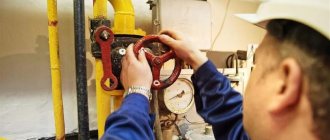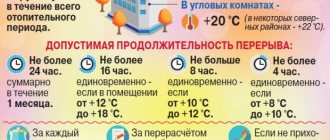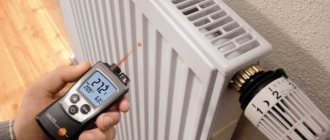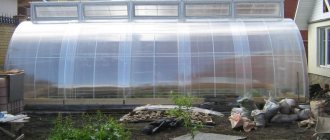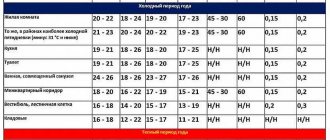Home » Miscellaneous
05/16/2021 Category: MiscellaneousAuthor: Olga Vladimirova
Preparation for the heating season begins immediately after its end. In the summer, repair and maintenance work is carried out to ensure the proper functioning of all systems and communications, and prevent premature breakdowns and wear of equipment. But a lot depends on weather conditions; usually heat supply in many regions of Russia is turned off in May, but sometimes this measure can be carried out later or earlier than expected. So, when will the 2021-2022 heating season start? The timing is affected by the climate in the country and the level of preparation of systems in local management companies.
- Heating season according to the law in Russia When does the heating season begin in Russia
- When does the heating season end in Russia?
Heating season according to the law in Russia
Until recently, heating seasons in the Russian Federation were regulated by specific deadlines. But due to the changeable weather, this turned out to be irrational; heat was used uneconomically in many regions.
In certain regions of Russia, frosts begin as early as October and can last almost until the end of spring. But there may be periods of warming during the winter season. And in recent years there have been quite a lot of them. Therefore, heating during these periods is pointless, and this leads to a large waste of heat.
The government took into account all these nuances and developed legislative documents and acts. The documents regulate relations in the field of heat supply. These include:
- On July 27, 2010, the Law “On Heat Supply” (No. 190-FZ) was adopted;
- As of May 6, 2011, the Decree of the Government of the Russian Federation “On the provision of public services” No. 354 is in force;
- On January 1, 2013, GOST 30494-2011 “Indoor microclimate parameters” was developed.
All of the above documents are used for owners and utility companies. They determine the start and end dates of heat supply.
When does the heating season begin in Russia?
The heating season is a period of time in which heat is supplied through centralized heating systems. Previously, six months were allotted for heating; the season began on October 15 and lasted until mid-April.
But due to the fact that many regions of Russia experience changeable weather conditions, the timing of the 2021-2022 heating season will depend on several factors:
- Average temperature per day;
- Weather information for the coming days.
If the temperature does not exceed +8 degrees for 5 days, then the administration may issue a decision on connecting heat to the region. If necessary, the start of the 2021-2022 heating season can be changed, moved forward or moved to other dates.
Below is indicated when the 2022 heating season begins in the main cities of the Russian Federation:
- Moscow – from September 25;
- In St. Petersburg from September 16 to October 1;
- In Tver, heating of public facilities will begin from September 23, and heating will be turned on in residential buildings from September 26;
- In Vladimir from September 23;
- In Yaroslavl from September 23-24 to October 1.
In Sochi, the heating season lasts three months, this is due to warm climatic conditions. In the city, heat supply is turned on on November 15, and it is turned off in early March.
When does the heating season end in Russia?
The 2021-2022 heating season in Russia is regulated by the weather, and if over the last 5 days the average daytime temperature is +8 degrees or higher, then the heat supply may be stopped.
But due to the fact that many regions experience variable climatic conditions, many local management companies are in no hurry to turn off the heating; they can extend it for several weeks. The fact is that restarting the system is quite a labor-intensive measure, and it is better to increase the period of heat supply than to connect it again.
In 2022, the dates for the planned shutdown of heat in the main regions of the Russian Federation were set:
- Moscow – from April 30 to May 2;
- St. Petersburg - April 27;
- Tver - April 29;
- Vladimir - April 23;
- Yaroslavl - April 27;
- Voronezh - April 19;
- Ufa – April 30.
When should it get warm?
In regions, houses begin to be heated at different times, depending on specific weather conditions and forecasts.
According to paragraph 5 of the Rules for the provision of utility services to owners and users of premises in apartment buildings and residential buildings:
If thermal energy for space heating needs is supplied to in-house engineering systems via centralized engineering support networks, then the contractor begins and ends the heating period within the time limits established by the authorized body.
The heating period must begin no later than and end no earlier than the day following the end of the 5-day period, during which, respectively, the average daily outside air temperature is below 8 degrees Celsius or the average daily outside air temperature is above 8 degrees Celsius.
The wording “no later” leaves the possibility of starting the heating season earlier than the five-day period described. The right to start the heating period exists all year round, but the obligation to start such a period arises on the day following the end of the 5-day period during which the average daily temperature was below +8°C.
Average daily temperature is defined as the arithmetic mean of the outside air temperature measured at certain hours of the day at regular intervals. Average daily temperature data is provided by the meteorological service.
Example: if it’s +12°C outside during the day and +2°C at night, then if the day and night periods are equal (12 hours each), the average daily temperature will be (12 + 2) / 2 = +7°C.
Local authorities give the command to start heating, and a resolution is drawn up on the start of the heating season, which can be seen on the official website of the city or district administration - the document must be published and is in the public domain. Heat supply organizations, management organizations and homeowners associations cannot turn on the heating on their own initiative. They only carry out the decisions of local governments.
If the deadline for heat supply, published on the municipality’s website, has already arrived, and the radiators in your house are cold, you need to call the emergency dispatch service or directly to the management authority (HOA). We wrote about how to properly submit an application to the ADS in an article about rusty water. They should explain to you why the delay occurred - perhaps problems were discovered in the system and are now being fixed. If they do not respond to your request, you can contact the State Housing Inspectorate, the city administration and Rospotrebnadzor. In the future, it will be possible to recalculate, we will talk about this in detail below.
In order not to freeze during the period when it is already cold and heating has not yet been provided, you can purchase a heater. This is perhaps the simplest and most effective solution for residents of high-rise buildings. You can also control the temperature in the rooms using air conditioning - this is especially important for families with small children, because the temperature in the nursery should be comfortable all year round.
Preparation for the heating season 2021-2022
Preparations for the 2021-2022 heating season will begin after the adoption of regulatory documents. It is prepared by local governments together with the heads of organizations that maintain residential facilities.
The resolution on the start of preparations for the heating season must be approved before April 30. It must contain the following information:
- Information about the authorized person who will carry out the operation and continuous maintenance of the main thermal power facilities. For these purposes, a specialist is appointed who has a higher education in the field of heat and power engineering. He must also undergo certification every year. The appointment of a deputy is carried out according to the same principle;
- The acts must indicate information about the members of the commission who will prepare energy complexes for their further operation. Their responsibilities include checking the readiness of thermal facilities, serviceability and normal functioning throughout the autumn and winter;
- Information regarding the beginning and end of the heating season;
- The documents must display a plan of activities that need to be completed in order to prepare the equipment for normal operation in the autumn-winter season. The plan must be agreed upon with all participants, and then it is approved;
- Indicates the algorithm for the procedure for reporting and monitoring preparatory activities, checking the condition and serviceability of thermal systems, devices, their readiness for connection;
- A procedure is being introduced for the order of activities and test work of all heat supply systems.
Which body is authorized to start the heating season?
In accordance with paragraph 4 of part 1 of Article 16 of the Federal Law of October 6, 2003 N131-FZ “On the general principles of organizing local self-government in the Russian Federation” (hereinafter referred to as Law N131-FZ), issues of local significance of a municipal formation include organization within the boundaries of this municipal formation electricity, heat, gas and water supply, water disposal, fuel supply to the population. , municipal legal acts by the population of municipalities directly and (or) local government bodies and local government officials .
From the above norms it follows that the organization of heat supply within the boundaries of a municipality relates to issues of local importance, and decisions on such issues are authorized to be made by local government bodies, and decisions on such issues are formalized by municipal legal acts.
Additionally, to avoid ambiguous interpretation of the above standards, it should be noted that clause 2.6.9 of the Rules and Standards for the Operation of the Housing Stock, approved by Resolution of the State Committee of the Russian Federation for Construction and Housing and Communal Sector dated September 27, 2003 N170, directly states that the beginning of the heating season is established local government bodies .
In addition, it is important to point out that in the absence of a legal act establishing the start date of the heating period, neither the RSO, nor the UO/HOA/housing cooperative have the right to start the heating period, even if the average daily outside air temperature for five days was less than +8.
Start of the heating season 2021-2022
Every year, heat connection in the regions is carried out at different times. But still, many citizens are concerned when the heating season begins according to the law in Russia in 2022?
To determine the date, several conditions are taken into account:
- Over the last 5 days, the weather should be stable and the temperature should not exceed + 8 degrees. If the connection is moved, then sudden frost may occur and this will lead to freezing of the heating systems. And as a result, companies will suffer serious losses, and the connection of heat supply may take a long time;
- The heat connection must be carried out between October 1 and October 15. But launching it earlier will be unprofitable, because the connection process is quite difficult and costly;
- The weather forecast for the next month is taken into account. If sharp warming is expected in the coming days, then connecting batteries in houses will be inappropriate. In this case, the dates may be postponed.
The essence of the false theory
The false theory discussed in this article can be divided into several postulates that can be applied both jointly and separately, and even in various combinations (depending on the level of illiteracy of individual adherents of such a theory): 1. Since it is the provider of public services (UO/HOA / housing cooperative) is responsible for the condition of the general building heating systems, then it is this utility service provider (ICU) who makes the decision on the start of the heating period; 2. Since hot water for heating needs is produced by a resource supply organization (RSO), it is such an organization that makes the decision on the start of the heating period; 3. Since tariffs and standards for utility heating services are approved by the state authorities of the constituent entity of the Russian Federation , it is these bodies that make the decision on the start of the heating period in the populated areas of the constituent entity of the Russian Federation; 4. The heating period can begin no earlier than a 5-day period has passed during which the outside air temperature is below 8 degrees Celsius. If, for example, such a condition is met for 4 days, and on the fifth day the temperature exceeds o for even a minute, it is prohibited to start the heating period.
Let's try to refute all of these false statements.
What to do if the heating season has begun, but the radiators are cold
If 5 days have passed after connection, and the batteries in the apartment are cold, then the following measures can be taken:
- Call the dispatch service of the utility company in Moscow;
- You can use the State Services website, where you can create an account and leave a request;
- The owner can contact MOEK employees by phone +7 (495) 539 59 59. The center is open around the clock, the operator will be able to accept applications at any time.
The apartment must maintain a temperature of at least +18 degrees. If heating devices do not support the recommended mode, it is better to contact the emergency service. The application can be submitted by telephone or in person.
Experts advise owners to contact the management organization, where they can obtain information regarding the timing of connecting and turning off the heat supply. The Housing Office has the required information.
Residents of apartment buildings should know the approximate timing of heating connection; this will help to detect problems with the system in time and identify a decrease in temperature. Poor performance and failure to fulfill the obligations of the regulatory company is a direct reason for filing a complaint and statement.
conclusions
From the above it follows that the authority to make a decision on the beginning of the heating period belongs to local government bodies , and not to the RSO, not to the municipal corporation/homeowners association/housing cooperative and not to the state authorities of the constituent entities of the Russian Federation (with the exception of the federal cities of Moscow, St. Petersburg, Sevastopol, in which such a decision can be made by state authorities). The start date of the heating period must be no later than the day following the end of the 5-day period, during which the average daily outside air temperature is below 8 degrees Celsius, while allow the heating period to begin before the end (or even the beginning) of the specified 5-day period forbidden .
Author: Nifontov D.Yu.
heating 33housing and communal services myths 29
Did you like the article?
Subscribe to stay updated on current articles and the most important housing and communal services news.
If the heating is turned off ahead of schedule
In winter, it is forbidden to turn off the heat in houses. Failure to pay for housing and communal services is not grounds for ending the heating season.
Government Decree No. 354 of 2011 indicates that the supply of water and heat is provided regardless of payment for these services.
valid reasons for temporarily stopping the supply of a resource in the middle of the season . For example, this is a serious breakdown of networks. At the same time, emergency shutdown must meet the requirements of the above Resolution.
This act establishes the following deadlines:
- if the room temperature is set within 12-18 °C - the maximum shutdown duration is 16 hours;
- at a temperature of 10-12 °C – 8 hours;
- when the room is 8-10 °C – 4 hours.
Immediately after stopping the heat supply, you need to draw up a report recording the temperature in the apartment. The cost of housing and communal services for hours while there was no heating is subject to compensation. In this case, payment is made for each hour of absence of heat.
Important! Residents should immediately contact utility services and call employees, otherwise temperature recording will not be legal. The document is generated in 2 copies.
If heat is not supplied within the established time frame, the citizen can contact the management company or the housing inspectorate. If there is no response to the appeal, residents turn to higher authorities.
The timing of the start of the heating period is regulated by the “Rules for the provision of utility services to owners and users of premises in apartment buildings and residential buildings” (approved by Decree of the Government of the Russian Federation on May 6, 2011 No. 354). The general rule is that the heating period should begin no later than the day following the end of the 5-day period during which the average daily outdoor temperature is below 8 degrees. The corresponding decision is made by the local government body.
But the preparation of the housing stock for the autumn-winter period (AWP) begins in the summer. To increase the efficiency of this work, local administrations approve plans that record activities and deadlines for their implementation.
In preparation for winter, a set of devices that ensure uninterrupted supply of heat to apartments is checked and necessary repairs are carried out: boiler rooms, intra-house networks, group and local heating points in houses, heating and ventilation systems. We carry out flushing and hydraulic tests, repairs, verification and adjustment of the in-house heating system. Work on behalf of residents is carried out by organizations that manage apartment buildings (management companies, HOAs, housing cooperatives) or resource supply organizations. Monitoring the progress of work to prepare for winter is carried out by local authorities, owners of premises in apartment buildings and housing supervision authorities.
Preparing an apartment building
to the passage of the heating season
(Slide 2)
In accordance with the Rules for assessing readiness for the heating season, approved by Order of the Ministry of Energy of Russia dated March 12, 2013 No. 103 (hereinafter referred to as Rules No. 103), consumers of thermal energy, including residential apartment buildings (MKD) must be prepared for the next heating season no later than September 15.
The main condition for preparing residential buildings for winter is their proper technical operation throughout the year and timely maintenance.
(Slide 3)
Depending on the method of managing the MKD, the responsibility for preparing the house for the next heating period rests with:
- management company servicing apartment buildings;
- owners of apartment buildings under direct management;
- HOA, housing cooperative.
Financing is carried out at the expense of the owners (“Rules for the maintenance of common property in an apartment building”, approved by Decree of the Government of the Russian Federation of August 13, 2006 No. 491). There are no budget funds allocated for preparing apartment buildings for winter!
(Slide 4)
The schedule for preparing the housing stock and its engineering equipment for operation in winter conditions should be drawn up taking into account the results of the spring inspection of residential buildings and deficiencies identified during the past winter period.
Monitoring the progress of winter preparation work is carried out by local government bodies, housing owners and their authorized representatives, as well as housing supervision authorities.
The start and end dates of the heating season are set by local governments. The heating period must begin no later than and end no earlier than the day following the end of the 5-day period, during which, respectively, the average daily outside air temperature is below 8 degrees Celsius or the average daily outside air temperature is above 8 degrees Celsius.
Local governments, taking into account the proposals of the organization that maintains this housing stock, also determine the start and completion dates for winterization of each residential building and infrastructure facilities.
Scope of work
(Slide 5)
When preparing the housing stock for operation in winter conditions, in accordance with the Rules and Standards for the Technical Operation of the Housing Stock (Resolution of the State Construction Committee of the Russian Federation dated September 27, 2003 N 170), it is necessary:
- by the beginning of winter, ensure high-quality repairs with the elimination of detected malfunctions of external enclosing structures: walls, roofs (especially without attics), attic floors, above technical undergrounds (basements), driveways, window and door fillings, as well as heating stoves, chimneys, gas ducts and installations with gas heaters (with checking the draft in chimneys and the condition of the heating stove automation);
- bring drainpipes and the territory of households into technically sound condition, ensuring unimpeded drainage of atmospheric and melt water from the building, including from descents (entrances) to the basement, window pits and blind areas;
- ensure waterproofing of foundations, basement and basement walls and their adjoining to adjacent structures, as well as normal temperature and humidity conditions in basements and attics.
(Slide 6)
The entire complex of devices that ensure uninterrupted supply of heat and hot water to all rooms and engineering structures is subject to preparation for winter (hydraulic testing, repair, inspection and adjustment):
- boiler rooms (if they are serviced by housing organizations),
- power networks to buildings maintained by housing organizations;
- points (central and individual);
- heating, ventilation and hot water supply systems.
Boiler rooms, heating points and units must be provided with automation equipment, instrumentation, shut-off control equipment, wiring diagrams for heating systems, hot water supply, hot water supply, supply and exhaust ventilation, designs indicating the use of equipment in various operating modes (filling, recharge, draining water from heating systems, etc.), equipment technical data sheets, operating charts, parameter logs, equipment defect logs.
Internal networks must be adjusted with adjustments to the calculated diameters of throttling devices at the thermal (elevator) unit.
Gas facilities must undergo adjustment of shut-off safety valves and pressure regulators for the winter period.
The equipment of pumping stations and fire-fighting equipment systems must be equipped with main and backup equipment, automatic switching on of backup pumps in case of failure of the main ones is ensured, adjusted and in good working order.
(Slide 7)
During the period of preparing the housing stock for work in winter conditions, the following is organized:
- training and retraining of boiler house workers, heating points, emergency service workers and maintenance workers, janitors;
- preparation of emergency services (vehicles, equipment, communications, tools and equipment, supplies of materials and personnel training);
- preparation (restoration) of diagrams of in-house cold and hot water supply systems, sewerage, central heating and ventilation, gas, indicating the location of shut-off valves and switches (for mechanics and electricians to eliminate accidents and malfunctions of in-house engineering systems);
- in unheated premises, they provide repairs to the insulation of water supply and sewerage pipes and fire-fighting water supply systems.
If there is water in the basements, you should pump it out, turn off and disassemble the irrigation water supply, and insulate the water metering unit; ensure uninterrupted operation of sewer outlets, inspection wells of the yard network and general outlets at the ends of the building from the collection pipeline laid in the basement (technical underground).
In unheated premises, during preparation for winter, you should check the condition and repair the insulation of water supply and sewerage pipes, central heating and hot water supply, and insulate the fire-fighting water supply system.
Vents in basements and technical undergrounds can be closed for the winter only in case of severe frosts.
(Slide 
Work performed in preparing residential buildings for operation in the autumn-winter period includes:
- insulation of window and balcony openings
- replacing broken glass windows and balcony doors
- insulation of entrance doors to apartments.
- insulation of attic floors
- insulation of pipelines in attics and basements
- strengthening and repair of parapet fences
- checking the serviceability of dormer windows and blinds
- production of new or repair of existing walking boards and walkways in attics
- repair, adjustment and testing of central heating systems
- repair of stoves and kitchen hearths
- insulation of boilers
- insulation and cleaning of smoke ventilation ducts
- replacement of broken glass windows and doors of auxiliary premises
- conservation of irrigation systems
- strengthening flag holders
- checking the condition of air vents in building basements
- repair and insulation of external water taps and standpipes
- supply of door closers for entrance doors
- repair and strengthening of entrance doors
!!! The scope of work and the timing of their implementation are reflected in the schedule, which is drawn up for a week, month and year.
Work to prepare a house for winter is carried out by a contractor for the maintenance of residential buildings and their engineering equipment. This is either a resource supplying organization with which a resource supply agreement has been concluded, or another specialized organization.
City specialized enterprises that own, lease or are in economic control of heat and water supply structures and utility networks are responsible for the quality and timing of bringing them into full working order by the heating season.
In the receipt for payment of housing and communal services, the costs of carrying out work to prepare for the heating season are included in the first line “Maintenance of common property”.
!!! When preparing an apartment building for the heating season, it is necessary to flush the in-house heating system and equipment. The most effective method of flushing is hydropneumatic flushing.
Why is flushing the heating system necessary?
(Slide 9)
Flushing the heating system is a set of operations to remove deposits in the heating system lines.
In the heating systems of most residential buildings, offices and enterprises, water, as is known, makes its own closed path. And it contains a whole “cocktail” of calcium salts, magnesium salts and even sludge, which tend to settle on the walls of radiators, pipes and boilers.
These deposits “grow” year after year, reducing the working cross-section of heating devices. This leads to the appearance of high thermal resistance, since scale does not conduct heat well, and at the same time the throughput of the pipes decreases. The consequence of this is an increase in energy consumption (fuel or electricity), since in order to maintain the temperature of the heating radiators at the required level, it is necessary to increase the heating temperature of the water in the boilers.
Interesting! Practical observations have shown that pipelines of heating systems with 10 years of operation are clogged with deposits by more than 50%. And every millimeter in the thickness of deposits increases fuel consumption by about 20-25%.
Thus, pipes and radiators of a 5-year-old structure already require a heating system flushing certificate. In principle, this is an ordinary “service” operation, without which long-term, high-quality operation of heating systems is impossible.
Assessing readiness for the heating season
(Slide 10)
Based on the results of the work done, the readiness of the apartment building for the heating season is assessed. It is carried out by carrying out relevant inspections by local governments of settlements and urban districts.
In relation to MKD, verification is carried out by determining compliance with the requirements of Rule No. 103:
- persons who, in accordance with housing legislation, manage an apartment building and purchase thermal energy (power) and (or) coolant for the provision of utility services in terms of heating and hot water supply. In relation to these persons, the measures taken by them to prepare for the heating season are also checked;
- persons who are the owners of residential and non-residential premises in an apartment building, who have entered into heat supply agreements with a heat supply organization in accordance with housing legislation.
In order to conduct inspections of thermal energy consumers, representatives of Rostechnadzor and the housing inspection may be included in the commission by agreement.
In order to conduct an inspection of thermal energy consumers, representatives of a single heat supply organization in the heat supply system, as well as the organization to whose heat and networks the heat consuming installations of thermal energy consumers are directly connected, can be involved in the work of the commission upon approval.
(Slide 11)
The readiness of housing and communal services facilities for operation in winter conditions is confirmed by the presence of:
- passports of the house’s readiness for operation in winter conditions (Appendix No. 9 of the “Rules and Standards for the Technical Operation of the Housing Stock”).
- acts on the serviceability of safety automation and control equipment (CPI) of boiler houses and engineering equipment of buildings.
- certificates of technical condition and serviceability of fire-fighting equipment.
- provision of fuel to boiler houses and the population before the start of the heating season: solid - not less than 70% of the heating season's demand, liquid - based on the availability of warehouses, but not less than the average monthly consumption;
- a supply of sand for sprinkling sidewalks at the rate of at least 3-4 m 3 per 1 thousand m2 of harvested area.
- acts on the readiness of harvesting equipment and equipment
- acts on readiness for winter with an assessment of the quality of preparation of buildings and apartments for winter and an act for each facility, as well as acts for testing, flushing, and adjustment of cold, hot water supply and heating systems.
!!! All acts are approved and submitted to the local government body by September 15.
The results of the inspection are documented in an act of checking readiness for the heating season (hereinafter referred to as the act).
The report contains the following conclusions based on the results of the inspection:
- the object of inspection (apartment building) is ready for the heating period;
- the object of inspection (apartment building) will be ready for the heating season, subject to the elimination of comments on the readiness requirements issued by the commission within the prescribed period;
- the object of inspection (apartment building) is not ready for the heating season.
The original of the inspection report is kept in the administration of the municipality, copies - in the management company, HOA, housing cooperative or housing owners (with direct management).
If the house is not ready for winter, the commission draws up a list of comments with deadlines for elimination. If ready, local authorities within 15 days issue a passport of readiness for the heating period. Passports are not issued to unprepared homes. After correcting the comments and re-checking, as well as with a positive conclusion from the commission, a repeated report is issued with a conclusion about readiness for the heating period, but without issuing a passport for the current heating period.
During the winter period, uninterrupted operation of sewer outlets, inspection wells of the yard network and general outlets at the ends of buildings from a common pipeline laid in the basement should be ensured.
After the end of the heating season, the equipment of boiler houses, heating networks and heating points, all heating systems must be tested with hydraulic pressure in accordance with established requirements.
Defects identified during testing must be eliminated, after which repeated tests are carried out. Tests of heating networks are carried out in accordance with established requirements.
Thank you for your attention!
In the next lesson we will cover the topic:
“The procedure for providing utilities, limits of responsibility, fines”
Heat shutdown in regions
The capital of the Russian Federation is located in the central region, for this reason the heating season ends in April or May . The exact dates are approved by municipality representatives every year.
The final decision on this issue is reflected, for example, on the website of the mayor of Moscow. The table shows the period during which heat is supplied to apartment buildings in the regions.
| Subject | Heating season |
| Altai region | From September to April |
| Arhangelsk region | From mid-September to mid-May |
| The Republic of Buryatia | From September to April-May |
| Volgograd region | From October to March |
| Irkutsk region | From September to May |
| Krasnodar region | From October to April |
| Magadan Region | From September to May |
| Rostov region | October-April |
| Saint Petersburg | September-May |
| Yakutia | September-May |
The exact dates change annually depending on the weather.
About coolant temperature standards
There is no uniform standard for the temperature of a heating radiator in an apartment during the heating period. According to Gosstroy Decree No. 170, Appendix No. 11, it is recommended that each boiler house have a schedule for quality regulation of the state of water in heating systems at calculated and current outside air temperatures. There are even two such graphs: for supply 95 0C, return 70 0C and 105-70 0C, respectively.
Based on these schedules, the resource supplying organization supplies coolant at the appropriate temperature. From large thermal power plants, superheated steam is supplied through the heating plant to heating points, where the temperature is brought to an acceptable level, after which the water enters the house heating network.
When calculating graphs, heat losses from the boiler room to the heating point must be taken into account. They are consistent with schedules drawn up directly for the heating system inside an apartment building.
When on frosty days boiler houses have to work at full capacity
With a two-pipe system, the permissible temperature of the coolant supplied to the risers should not exceed 95 degrees. This is due to safety issues, sanitary and hygienic requirements of SanPiN 2.1.2.2645-10 “Heating Standards in an Apartment”. At the same time, the systems must heat the air evenly, not pollute the surrounding atmosphere with harmful substances, and not create noise.
On the other hand, 95 degrees is the maximum temperature permissible for risers made of polypropylene or PE-x/EVON pipes. This material is widely used for piping thermal systems in modern construction.
The temperature indicator of the heating elements does not play a big role. In reality, the thermal conductivity of the material from which the batteries are made and the number of sections are important. Aluminum heating elements and bimetallic radiators have the greatest heat transfer.
In terms of this indicator, cast iron batteries occupy one of the last places among industrially produced heating elements; only the heat transfer of converters is lower. At the same time, cast iron sections accumulate deposits of salts present in the coolant to a greater extent, which helps to reduce the flow area, and the normal temperature of the heating radiators in the apartment or other rooms is not achieved.
Important! When supplying coolant in a riser, it is impossible to change the wiring diagram or replace heating devices without the approval of the management company.
As the outside temperature decreases, the batteries should become warmer and provide comfort to the apartment residents. In any case, heating of heating devices should not exceed 95 degrees (SanPiN 2.1.2.2645-10). On the other hand, excessive heat in the room is also not desirable.
Heating shutdown procedure
The heat in the apartment is turned off in several stages. The reason is that the equipment is subject to a great deal of stress during heating on and off.
The algorithm looks like this:
- Initially, the heat supply is turned off at industrial facilities, including factories;
- The heating season in apartment buildings is ending;
- the heat supply system in social institutions, for example, schools and kindergartens, is turned off.
During the heating season, an unstable climate may develop, then the optimal behavior is to gradually reduce the temperature.
Shutdown date
Today, all government agencies have official websites that contain up-to-date information. This also applies to the end of the heat supply season. After authorized organizations make such a decision, the date is reflected on the portal.
Also, information about the completion of heating in the municipality can be obtained by calling the local administration or management company. Local government officials have a responsibility to ensure that information about the loss of heat supply is published in the media.
Normal temperature in the house
Temperature standards in a residential building are specified in GOST R 51617-2000. Housing and communal services. General technical conditions". According to this document, during the heating season, the temperature in living rooms should not fall below 18 degrees Celsius, and in the bathroom below 25 degrees.
In this case, several subtleties should be taken into account. Thus, the document states that during the heating season, the upper temperature limit for living rooms is 24 degrees. It is also worth noting that the minimum temperature in living rooms should not be lower than 20 degrees. On the staircase in the entrance of a residential building, it should not fall below 14 degrees, and in the inter-apartment corridor - below 16 degrees.
At night, for living rooms, temperature deviations downward from the lower limit of the range are allowed, but not more than three degrees. The night period is considered to be the time period from midnight to five o'clock in the morning.
Events
Heating off
What happens after housing owners receive a resolution from a higher organization to end the heating season?
| Event | Actions |
| Stop heating | The house valves of the supply and return pipelines are completely closed. The heating system remains filled throughout the summer; if repairs are necessary, it is discharged through risers and refilled with water after completion of work |
| DHW switching | In houses without circulation connections, the DHW supply is switched to the supply pipeline. In elevator units with circulation taps, the hot water supply switches to the circulation mode “from supply to return” |
Both valves 4 and the lower valve 3 are closed. The upper valve number 3 is open.
Temperature tests
In the spring, when the heating season ends (or shortly before its end), the radiators in apartments heat up especially strongly. Since the streets are quite warm at this time, the heat, of course, evokes strong and quite unambiguous feelings among homeowners.
Contrary to popular belief, this is not stupidity or wastefulness. At the beginning of May, heating systems are tested for temperature. Thus, in heating mains and house systems, all potential problems associated with burnout of organic sealants and thermal expansion of pipeline elements are identified.
The essence of the tests is simple and clear: at a constant pressure, the supply temperature rises to a maximum of 130-150 degrees.
The rules for preparing for temperature tests are not complicated: the DHW is turned off completely; The heating is operating normally.
Hot water is turned off during testing.
Density tests
Some time after the date when the heating season ends, another test is carried out - for density. Only heating mains are tested; the pressure in them rises from the standard 6-7 to 10-12 kgf/cm2 on both lines. At the same time, the coolant temperature drops to street temperature.
Why is this necessary? So that, at a time when the repair of the route does not lead to the defrosting of houses and entrances, we can identify all the weak points of the pipelines and organize their timely repairs.
A break in the track during density testing.
Here are instructions for conducting density tests for employees of housing service organizations.
| Event | Actions |
| Disconnecting the elevator unit from the route | The input valves in the elevator assembly are closed. At the same time, the hot water supply is also shut off - so that the cold water entering the hot water supply system through the mixers in the apartments does not flood the elevator premises through the discharges |
| Reset organization | 1-2 control valves open in the elevator unit |
Let us clarify: the last point is necessary so that when the inlet valves are pressurized, the pressure of 10-12 atmospheres does not destroy the heating system. Water is practically incompressible, and very little of it is needed to increase pressure in a closed circuit.
The completion date of the tests depends, first of all, on the presence or absence of accidents. As a rule, they last from a day to two.
Flushing
Another activity that is carried out after the heating stops or shortly before it is flushing the heating system of the house.
Most often it is performed using the hydropneumatic method:
- The heating system starts to be discharged into the sewer. When the supply valve is open and the return valve is closed, the vent on the return side opens.
- Compressed air is pumped into the supply through the control valve.
- After a few hours, the direction of movement of the pulp changes to the opposite.
The results of flushing are assessed by a heating network representative. As a rule, the assessment comes down to checking the contents of the entrance and apartment heating radiators: the lower blind plugs are unscrewed from them.
Compressor for hydropneumatic washing.
Inspection of shut-off valves
The action plan to prepare for the heating season includes:
- Inspection of shut-off valves of elevator units.
- Inspection of the condition of elevator nozzles and (if necessary) welding, boring or replacing them.
An inspection of shut-off valves is accompanied by its repair and (in case of non-repairability) replacement. Since the price of valves is quite high, they try to repair them - welding on worn wedges and grinding the cheeks. Preparing one valve for operation can take up to half a working day.
The photo shows an inspection of the valve on the stand.
How long the actual repair of the fittings lasts is not important: a representative of the heating networks can be invited for an inspection on any day before the start of the next season. Checking the condition of the shut-off valves is extremely simple: after all the valves in the assembly are closed, no water should flow through the open control valve.
To check, just close all the valves and open any control valve.
Based on the check, a subscriber’s readiness report is drawn up, after which a passport of readiness for the next season is issued to the house.
